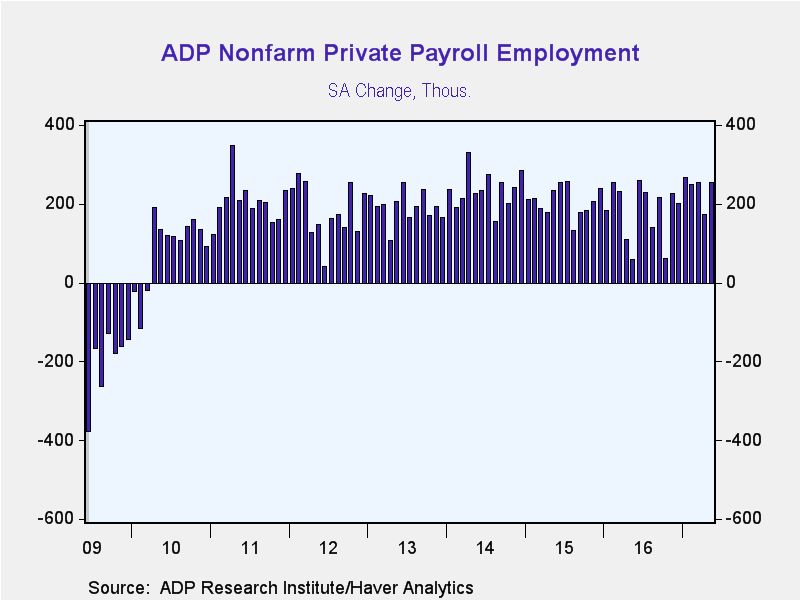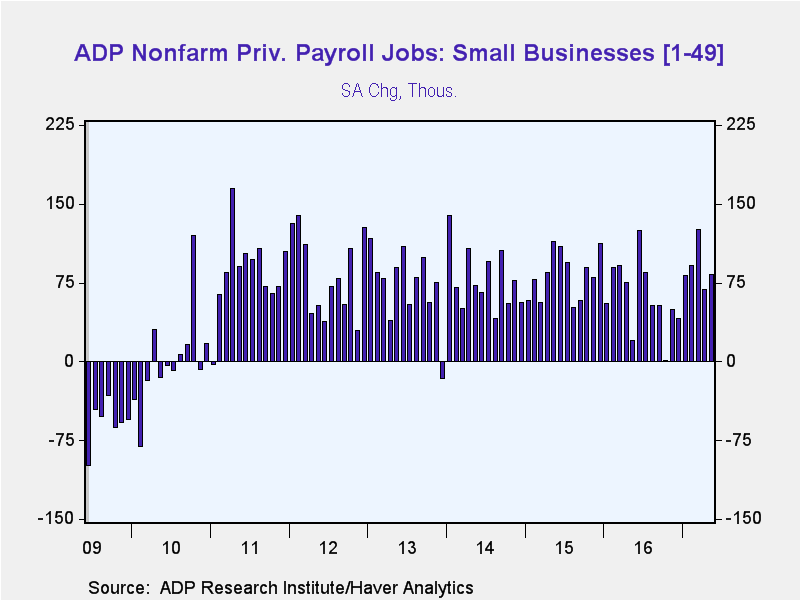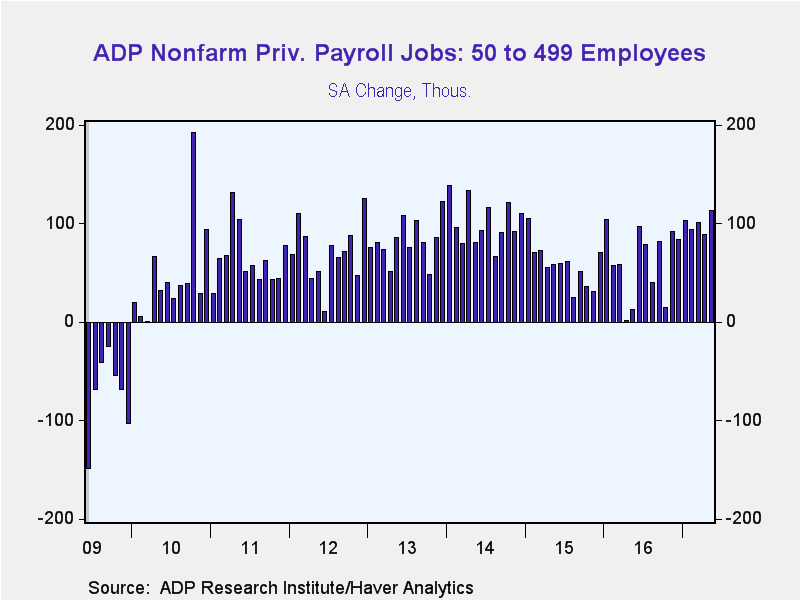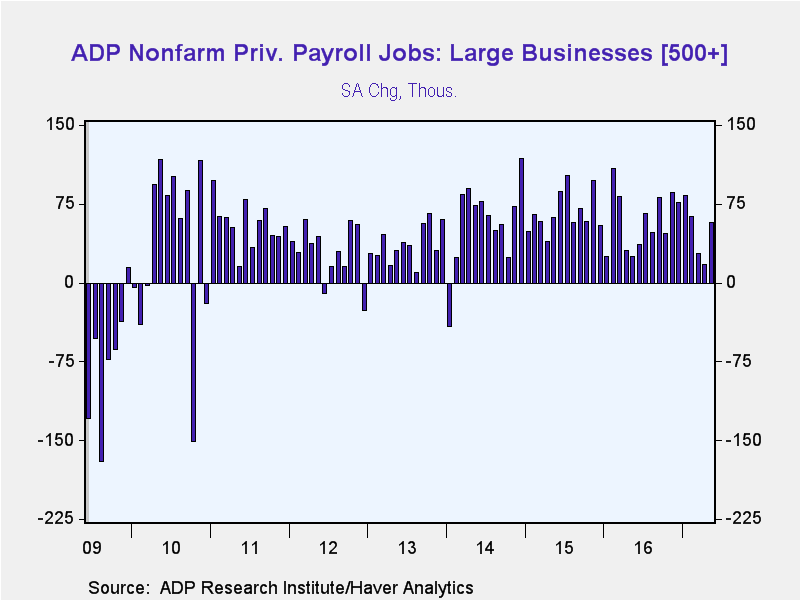 Global| Jun 01 2017
Global| Jun 01 2017U.S. ADP Private Payrolls Strengthen
by:Tom Moeller
|in:Economy in Brief
Summary
Business hiring remains firm. The ADP/Moody's National Employment Report indicated that private nonfarm payrolls increased 253,000 (2.1% y/y) during May following a 174,000 April rise, revised from 177,000. A 180,000 increase had been [...]
Business hiring remains firm. The ADP/Moody's National Employment Report indicated that private nonfarm payrolls increased 253,000 (2.1% y/y) during May following a 174,000 April rise, revised from 177,000. A 180,000 increase had been expected in the Action Economics Forecast Survey. During the last ten years, there has been a 96% correlation between the change in the ADP figure and the change in nonfarm private sector payrolls as measured by the Bureau of Labor Statistics.
The Automatic Data Processing Research Institute survey is based on ADP's business payroll transaction system covering 411,000 companies and nearly 24 million employees. The data are processed by Moody's Analytics Inc., then calibrated and aligned with the BLS establishment survey data. The ADP data cover private sector employment only.
Small-sized business payrolls increased 83,000 (1.7% y/y) following a 68,000 rise. Both figures were below the February & March increases of 91,000 and 126,000. Medium-sized payrolls strengthened 113,000 (2.3% y/y), the strongest increase since October 2014. Large-sized payrolls gained 57,000 (2.5% y/y), the firmest rise in three months.
Employment in the goods-producing sector improved 48,000 (1.9% y/y) following a 6,000 increase. These figures were well below the increases during the prior three months. Construction sector payrolls recovered 37,000 (3.9% y/y), following a 7,000 decline. Employment in the factory sector improved 8,000 (0.9% y/y) following a 6,000 rise. These gains fell short of the 31,000 average during Q1. Private service sector payrolls rose 205,000 (2.1% y/y), the strongest increase in six months. Professional & business services payrolls jumped 88,000 (3.5% y/y), by far the strongest gain since April 2014. The number of trade, transportation and utilities jobs increased 58,000 (1.3% y/y), the strongest rise since December. Financial activities jobs grew 7,000 (2.0% y/y), nearly the slowest increase of the last four years. Employment in the information sector dropped 8,000 (0.0% y/y), continuing the declines registered since early last year.
The ADP National Employment Report data are maintained in Haver's USECON database; historical figures date back to April 2001 for the total and industry breakdown, and back to January 2005 for the business size breakout. The expectation figure is available in Haver's AS1REPNA database.
The latest Beige Book covering regional economic conditions is available here.
| ADP/Moody's National Employment Report | May | Apr | Mar | May Y/Y | 2016 | 2015 | 2014 |
|---|---|---|---|---|---|---|---|
| Nonfarm Private Payroll Employment (m/m chg, 000s) | 253 | 174 | 255 | 2.1% | 1.9% | 2.3% | 2.2% |
| Small Payroll (1-49) | 83 | 68 | 126 | 1.7 | 1.9 | 1.9 | 1.8 |
| Medium Payroll (50-499) | 113 | 89 | 101 | 2.3 | 1.5 | 2.3 | 2.8 |
| Large Payroll (>500) | 57 | 17 | 28 | 2.5 | 2.8 | 3.0 | 2.1 |
| Goods-Producing | 48 | 6 | 79 | 1.9 | 0.8 | 2.0 | 2.6 |
| Construction | 37 | -7 | 44 | 3.9 | 4.1 | 5.2 | 4.9 |
| Manufacturing | 8 | 6 | 31 | 0.9 | 0.2 | 1.2 | 1.4 |
| Service-Producing | 205 | 167 | 176 | 2.1 | 2.2 | 2.3 | 2.2 |
Tom Moeller
AuthorMore in Author Profile »Prior to joining Haver Analytics in 2000, Mr. Moeller worked as the Economist at Chancellor Capital Management from 1985 to 1999. There, he developed comprehensive economic forecasts and interpreted economic data for equity and fixed income portfolio managers. Also at Chancellor, Mr. Moeller worked as an equity analyst and was responsible for researching and rating companies in the economically sensitive automobile and housing industries for investment in Chancellor’s equity portfolio. Prior to joining Chancellor, Mr. Moeller was an Economist at Citibank from 1979 to 1984. He also analyzed pricing behavior in the metals industry for the Council on Wage and Price Stability in Washington, D.C. In 1999, Mr. Moeller received the award for most accurate forecast from the Forecasters' Club of New York. From 1990 to 1992 he was President of the New York Association for Business Economists. Mr. Moeller earned an M.B.A. in Finance from Fordham University, where he graduated in 1987. He holds a Bachelor of Arts in Economics from George Washington University.










